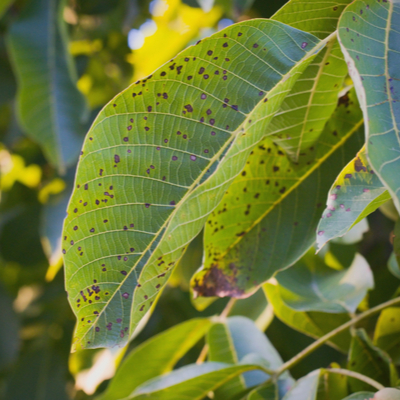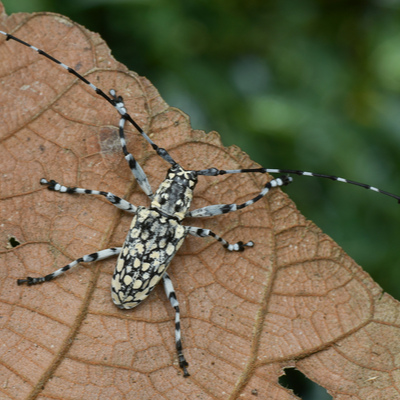Trees are windows into nature. Essential to our well-being, trees provide us with oxygen to breathe, shade from the sun, capture rainfall, reduce temperatures, help maintain both air and sound pollution, and are as timeless as the earth itself. They reduce stress, emanate a sense of calm, and provide a web of safety around our homes. No wonder the residents of Florida value their beloved trees so much. At Flowers Turf & Pest Management, we do as well. That’s why we offer a tree and shrub program to help prevent pests and diseases from taking over and destroying these beautiful lawn ornaments. As strong as they appear, trees are susceptible to the same elements as your lawn, heat, drought, over-saturation, fungi, and pests. This article discusses the most common pests that destroy trees in Florida.
The Most Common Tree Diseases Found in Florida
Anthracnose
Anthracnose is a fungus that can attack any type of tree but seems to prefer ash, oak, maple, dogwood, and sycamores. The anthracnose fungus is caused by overwintering fungi in cankers that reside on twigs. In the spring, the cankers produce spores that spread to other trees in cool, wet weather. Symptoms include small dead spots on the leaves, and eventually, the entire leaf falls off. Anthracnose can spread quickly from tree to tree through the wind, insects, rain, and even tools humans use. The fungus can also affect the fruit on fruit trees, causing the fruit to develop sunken dark spots and rot. While there are fungicides that can help treat this disease, prevention is the best key to maintaining a healthy tree through regular fertilization and watering.
Verticillium Wilt
Verticillium Wilt is a common fungal disease found in deciduous trees. The fungus lives in the soil and invades susceptible trees and plants through their roots. It is hard to diagnose because the symptoms mimic the same symptoms of other diseases. When a plant, tree, or shrub is infected, it’s leaves will wilt and curl and turn yellow and red. Eventually, they turn brown and drop off. As the disease travels through the tree or shrub, it leaves dark discolorations. It is not uncommon to see symptoms on one side of the plant but not the other. Once the fungus enters the plant, there is no cure. The best way to treat Verticillium wilt is through prevention and giving your trees and shrubs the best possible care and maintenance you can provide. This includes proper irrigation, fertilization, and pruning.
Asian Long-Horned Beetle
This destructive pest is approximately 1.5 inches long. It is black with white spots on its wings. Eerily, they have a black and white antenna that can be up to twice as long as their body. Female beetles chew holes into the bark where they deposit one to two eggs at a time, laying up to 60 eggs on average. After the eggs hatch, the young bore into the tree and begin to feed on the living tissue right underneath the bark. Like many other diseases above, this disrupts the flow of water and nutrients within the tree.
Symptoms of ALB infestations include:
- Small exit holes on branches and limbs
- Depressions in the outer bark
- Sap oozing from egg-laying sites and exit holes
- Sawdust collections at the base of the tree
Tree death usually occurs within seven to nine years after the first infestation. As with the other diseases, the only real way to control the ALB is through prevention and good tree maintenance. It is also important to remember never to transport firewood.
Fusiform Rust
This is one of the most destructive tree diseases found throughout the southeast US and Florida. Fusiform rust is a stem disease that’s caused by a fungus. Native pine trees are particularly vulnerable.
Some common symptoms of fusiform rust include:
- Cigar-shaped galls appear on the main stem of the tree
- Yellow-orange blisters
- Rust-colored spores found when the infected trunk or branch breaks open
Treating this disease quickly can save the life and look of your ornamental tree. Since infected trees become structurally unstable, if left untreated, your tree may have to be removed entirely to prevent safety hazards. If caught in time, however, often a professional landscaper can remove the infected areas and leave the majority of the tree intact.
For All Your Tree and Shrub Care Needs, Contact the Professionals at Flowers Turf & Pest Management
At Flowers Turf & Pest Management, we can help you maintain the health and vitality of your trees and shrubs. Our tree and shrub program includes the appropriate fertilization, deep-root fertilization, and a dormant oil application that will help protect your trees from any of the above fungi or disease-carrying pests. Call us today to learn more. You can reach us at (321) 254-1929. You can also request a quote online. For the latest offers and deals, make sure to like us on Facebook!

